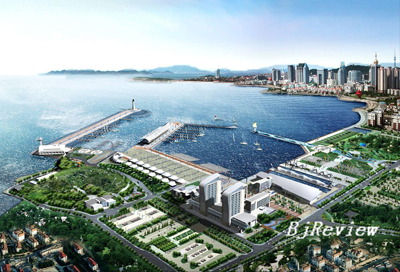
In May every year when the cherries are ripe, large quantities of the fruit produced in Shandong Province are shipped to northeast China via the Yantai Port. With water transport, people in the northeast can eat these delicious cherries only six hours after they are loaded on the freighters in Shandong. With land transport, the journey would take days, covering about 1,800 km.
With 3,121 km of coastline, Shandong is abundant in coastal and marine resources, and its ocean resource areas are almost equal to its land areas. According to assessment by the National Marine Data and Service, in terms of six kinds of marine resources, namely tidal land, shallow sea, ports, salt flats, tourism and placer deposits, Shandong ranks first among all coastal provinces in the country.
Port economy
The sea route from Shandong's Yantai Port to Liaoning's Dalian Port links the Liaodong Peninsula and the Shandong Peninsula across the Bohai Sea. With the shortest direct distance of 89 sea miles (160 km), it is the most convenient transportation route linking east China, which has the most developed economy in the country, with northeast China, which has rich resources. This stretch of ocean is also called the "golden sea route."
With 145 years of development, Yantai Port now boasts 75 berths and 6.8 billion yuan of assets. In 2006, the Yantai Port Group Co. Ltd. handled up to 3.96 million passengers and 80.88 million tons of cargo, including 1.17 million TEU, ranking 10th among the country's total, said Li Liming, Deputy Secretary of the group's Party committee.
Moreover, the railway ferry from Yantai to Dalian has been put into trial operation since November 6, 2006. With the total length of 159.8 km, it is China's first railway ferry route that exceeds 100 km. The sea route from Yantai to Dalian, which once saw frequent marine accidents because of treacherous ocean geographic conditions, will now be a safer journey.
Besides domestic transportation, Yantai Port also has sea routes linking more than 100 ports in 70 countries and regions in the world. With its proximity to Japan and South Korea, Yantai Port has attached great importance to fostering marine transportation business with the two countries. "Although we cannot beat the ports in Liaoning Province in business with Japan, we do contend with Liaoning in business with South Korea," said Li.
Aquatic industry
Shandong also has abundant fishery resources. "We are the largest fishery province in China, having more than 400 varieties of aquatic biological resources and over 70 aquatic varieties that can be raised in coastal waters," said Tian Liang, division chief of the Department of Oceanic and Fishery of Shandong Province.
Shandong Oriental Ocean Science and Technology Co. Ltd. (SOOST) is an aquatic company engaged in fishery production and processing, seawater aquaculture, breeding and cultivation, international trading and bonded storage. According to Li Cunming, General Manager of SOOST, which was listed in the Shenzhen Stock Exchange in November 2006, the market value of the company totals 2.6 billion yuan, and by the end of 2006, it had 4 billion yuan of net assets and generated 270 billion yuan in sales revenue.
"All of our fishery processing products are exported, with 90 percent going to the European market and the remaining 10 percent to the United States and Canada, and most of our materials are from European countries such as Denmark, Sweden and Norway," said Li.
|
